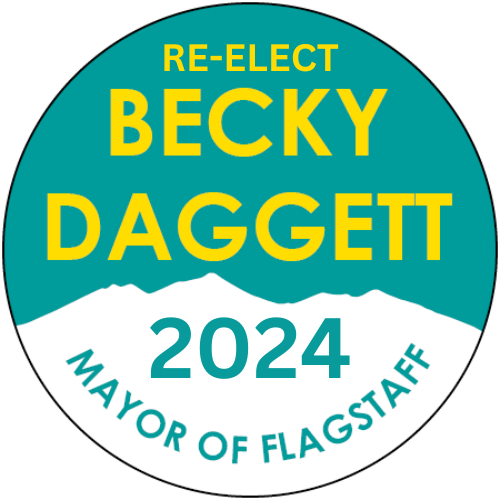I will always listen to community members and sincerely consider their ideas, concerns, and perspectives as a critical part of my decision making process. I only commit to a course of action after listening, asking questions, seeking out those with subject area expertise, and careful study. If you have additional information you think I should consider, please email me your thoughts.
A work in progress…
In recognition of the emergency we’re in, the city declared a climate emergency in 2020 and adjusted our climate goals from 80% reduction in Green House Gas (GHG) emissions by 2050 to carbon neutrality by 2030.
According to the 2018 Climate Profile for The City of Flagstaff:
- projections of Coconino County’s average temperature are even higher than projections for the global average temperature
- projections for the year 2050 range from 4-5°F higher than the current average
- through 2017, the average number of days above 90°F in Flagstaff was 2 days per year. The projected change in the number of days above 90°F range from just under 30 days per year (lower scenario) to as many as 80 days per year (higher scenario) by the end of this century.
- locally, transportation and building energy account for 87% of our GHG emissions
Transportation is the largest local emitter of GHGs and yet while the council was approving the Climate Action and Adaptation Plan (CAAP), they were putting nearly $400 million in road construction projects on the ballot. The transportation tax process was devoid of meaningful input from either the sustainability or housing departments.
We must ensure that all transportation projects are planned in accordance with our CAAP goals and design transportation that’s more efficient than private automobiles. Because building energy is the second biggest GHG emitter, we also need to ensure that all municipal construction projects meet CAAP goals and retrofitted energy efficient projects are undertaken for existing city buildings. Developing renewable energy production strategies, both distributed and on-site, are also necessary.
I believe there is an economic development opportunity in meeting our climate goals.
I’ve been an advocate for protecting open space for many years. As the executive director of Friends of Flagstaff’s Future, I was involved in nearly every major land use planning effort, including planning for and purchasing valuable land on Observatory Mesa, an ephemeral wetland at Rogers Lake, lands at Picture Canyon and Pumphouse Wash, and pieces of land on which to build segments of the Flagstaff Urban Trail System. All told, I was campaign manager for three successful ballot measures raising more than $50 million to purchase these lands, build portions of the FUTS, and build parks.
The city council that included Art Babbott, Kara Kelty, and Al White voted unanimously to annex this 3.06 acre parcel, amend the regional plan, rezone it from neighborhood commercial to medium density residential, and purchase it for $140,200 for the purpose of affordable housing. The city then spent $435,167 bringing infrastructure to the parcel for a total investment of $575,367 as part of a plan to create affordable housing. An amendment to the regional plan and a rezoning requires substantial public comment. Upon reviewing several months of council minutes, I counted seven public hearings where comments were taken, there may have been more. Here’s a summary of the city’s actions regarding this parcel.
The city currently owns 4.83 acres, including this parcel, of buildable land which is identified for affordable housing and ready or nearly ready for development. The other two parcels, totaling 1.77 acres of buildable land, need to be rezoned and have utilities brought a short distance to the sites. Removing these three acres exacerbates an already crisis situation. Therefore, I cannot support rezoning this land from housing to open space.
From a social and climate justice perspective, this small parcel is an ideal location for affordable housing. Not only is it located next to the urban trail and a bus route, but it is also within walking distance to a park and one of the best elementary schools in town. A functional democracy requires that our elected officials look out for the less powerful and this is why the city council needs to make affordable housing a priority. Every person in Flagstaff is entitled to enjoy the beauty around us and to have safe, secure, and affordable housing.
As previously stated, I value open space, and am proud that I began working 20 years ago to help protect thousands of acres of ecologically important lands in and around Flagstaff. Strong public policy requires weighing the costs, benefits, needs and opportunities for our community for every decision that comes before council. This parcel has had $575,000 in taxpayer money invested in it and is surrounded by 80 acres of privately owned land on which development will significantly alter the look and feel of this parcel.
After carefully weighing all of the factors, I don’t think we should miss an opportunity to fulfill a critical need for housing faced by working people in our community.
Higher densities make transit, biking, and walking more feasible, help address affordable housing, and are better for the environment—resulting in lower energy and water consumption than single family homes. As we develop in a denser fashion, we’re experiencing growing pains as new is out of scale with existing low-density development. That said, I don’t support housing designed exclusively for students.
I understand the concern about increasing density in new developments as it’s unnerving to see buildings like the Standard or the Hub built in low-density areas. I support increased densities in new development; however, it should be scaled and nearby neighborhoods involved in discussions.
We need strong leadership to guide change. With the right leadership, we can create a city that’s inclusive, well designed, creates meaningful work opportunities, fosters a culture of creativity, and celebrates the beauty and benefits of a healthy natural environment.
